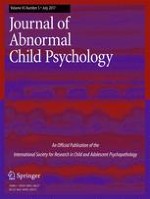26-09-2016
Longitudinal Associations between Depression and Aggression in Children and Adolescents
Gepubliceerd in: Research on Child and Adolescent Psychopathology | Uitgave 5/2017
Log in om toegang te krijgenAbstract
Due to the longstanding and detrimental effects of engaging in aggressive behaviour and of experiencing symptoms of internalizing problems in children and adolescents, there is an increasing interest in identifying the temporal sequence between these 2 problems with previous research yielding inconsistent findings. Therefore, the longitudinal links between relational aggression, physical aggression, and depression were examined across 7 years in a sample of 643 children (54 % girls) aged 10 at Time 1. Three models were compared— (1) the failure model, in which aggression predicted depression, (2) the acting out model, in which depression predicted aggression, and (3) a reciprocal model, in which both aggression and depression shared a reciprocal relation over time. Cross-lagged path analyses using structural equation modeling supported the failure model (i.e., engaging in relational and physical aggression predicts subsequent depressive symptoms). Findings were similar for boys and girls. These findings add to the literature suggesting that externalizing problems precede internalizing problems.
